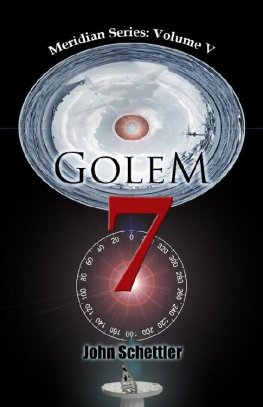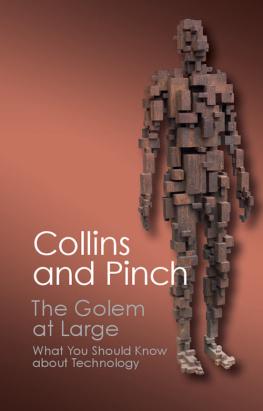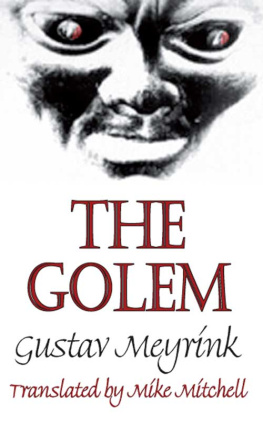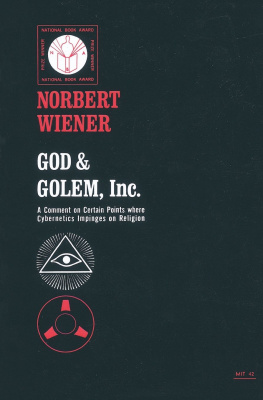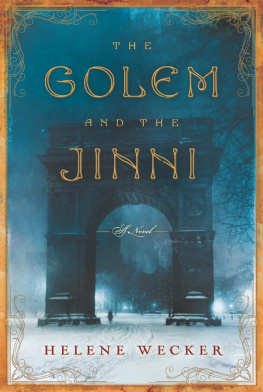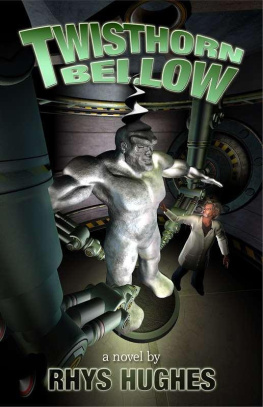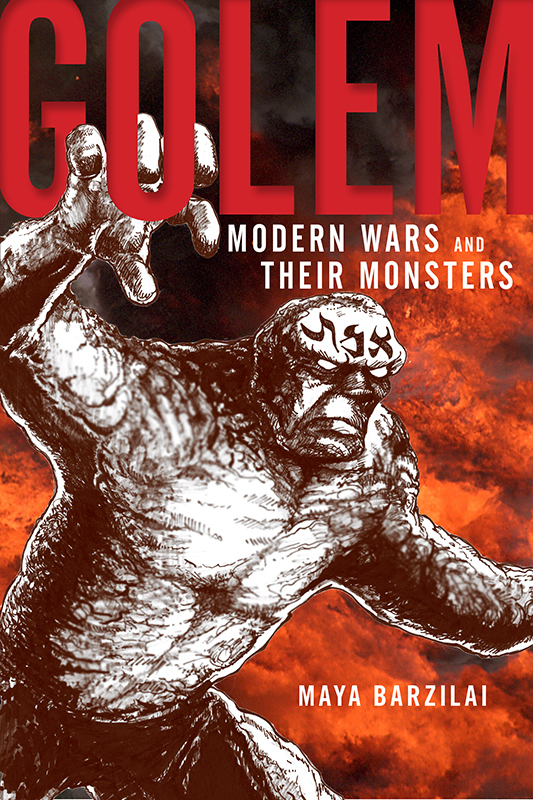
Golem
Golem
Modern Wars and Their Monsters
Maya Barzilai

NEW YORK UNIVERSITY PRESS
New York
NEW YORK UNIVERSITY PRESS
New York
www.nyupress.org
2016 by New York University
All rights reserved
References to Internet websites (URLs) were accurate at the time of writing. Neither the author nor New York University Press is responsible for URLs that may have expired or changed since the manuscript was prepared.
Library of Congress Cataloging-in-Publication Data
Names: Barzilai, Maya, author.
Title: Golem : modern wars and their monsters / Maya Barzilai.
Description: New York : New York University Press, [2016] | Includes bibliographical references and index.
Identifiers: LCCN 2016017269 | ISBN 9781479889655 (cl : alk. paper)
Subjects: LCSH: Golem. | War.
Classification: LCC BM531 .B37 2016 | DDC 296.3/827dc23
LC record available at https://lccn.loc.gov/2016017269
New York University Press books are printed on acid-free paper, and their binding materials are chosen for strength and durability. We strive to use environmentally responsible suppliers and materials to the greatest extent possible in publishing our books.
Manufactured in the United States of America
10 9 8 7 6 5 4 3 2 1
Also available as an ebook
For Shuli and Eli Barzilai
The resemblance of [the golem of Prague] to the golems of our nuclear age staggers the imagination. While we attempt to surpass our enemies and to create new and more destructive golems, the awful possibility is lurking that they may develop a volition of their own, become spiteful, treacherous, mad golems. Like the Jews of Prague in the sixteenth century, we are frightened by our golems. We would like to be in a position to erase the uncanny power we have given them, hide them in some monstrous attic and wait for the time when they too will become fiction and folklore.
Isaac Bashevis Singer
Contents
Golem creation is a dangerous undertaking, but so too is writing books about golems. Both activities require total immersion and can entail the creators own destruction. I have managed to emerge unscathed from the lengthy and arduous process of molding what has finally become this book only because of the ongoing support of mentors, colleagues, friends, and family. They prevented me from being crushed by my own creation, and it is to them that I owe this book.
At the Hebrew University, Ruth Ginsburg and Shlomith Rimon-Kenan initiated me into the academic world and challenged me to read carefully and deeply. The gift of their intellectual mentorship and personal friendship still nourishes me to this day. At UC Berkeleywhere I first began to think and write about the golem as a figure of warI had the fortune of engaged and supportive advisors whose work continues to enrich my own. Robert (Uri) Alter unfailingly backed my intellectual pursuits and shared his wealth of knowledge about Hebrew literature and S. Y. Agnon in particular. Chana Kronfelds invaluable and generous feedback on my work has not only greatly enhanced my writing but also provided me with a role model of passionate mentorship and rigorous scholarship. Anton (Tony) Kaess Weimar film seminars at Berkeley shaped the way I think about the (moving) image, and I am grateful to him for innumerable thought-provoking conversations, for his savvy advice, and for his help with the books arguments and title. I am also grateful for the stimulating intellectual environment that other faculty and students at Berkeley provided, in particular, Michael Andr Bernstein, Daniel Boyarin, Yael Chaver, Naomi Seidman, Kaja Silverman, Naomi Brenner, Katra Byram, Lital Levy, Noam Manor, Sabrina K. Rahman, Allison Schachter, Shaul Setter, and Zehavit Stern.
At the University of Michigan, I have been blessed with welcoming chairs and exceptional colleagues to whom I could turn for advice. Deborah Dash Moore always had her door open and helped me navigate the academic publishing world. She also provided valuable comments on portions of the book. In addition to branding golem studies, Geoff Eley engaged my work and offered his friendship and support. Jonathan Freedman has shared my fascination with all things on the borders of Jewishness, providing sharp feedback and heartening advice. Mikhael Krutikov has been an amazing resource on Yiddish culture, taking an interest in my work and offering incisive feedback on chapter 2. The erudite Shachar Pinsker provided crucial references and shared his insights into the writing process. Rachel Neis believed in me and in the project from day one. I cannot thank her enough for her brilliant feedback, her willingness to answer calls at all times of the day (and night), and her keen sense of humor, which has kept me afloat. Anita Norich has been the finest mentor a young faculty member could ever hope for. She guided me through every aspect of the writing and publishing process, commenting on numerous drafts of the project. Her encouragement, wisdom, and warmth have made Ann Arbor feel more like home.
Other colleagues at Michigan have contributed to this project, and I feel fortunate to work in their midst. Levana Aronson, Kathryn Babayan, Carol Bardenstein, Kerstin Barndt, Sara Blair, Sigrid Anderson Cordell, Deirdre de la Cruz, Elliot Ginsburg, Gottfried Hagen, Doron Lamm, Christi Merrill, Piotr Mikhalowski, Joshua L. Miller, Johannes von Moltke, Regina Morantz-Sanchez, Ellen Muehlberger, Yopie Prins, Anton Shammas, Scott Spector, Jindrich Toman, and Jeffrey Veidlinger all offered helpful advice and many words of encouragement. Eitan Bar-Yosef, a visiting fellow from Ben Gurion University, has been a valuable interlocutor and celebrated important milestones with me.
My year as a fellow at the Frankel Institute for Advanced Judaic Studies, under the energetic leadership of Jonathan Freedman, was influential for the formation of this book. It was there that I had the mental space to reconceive the project and the opportunity to workshop my writing. I thank my cofellows Lois Dubin, Harvey Goldberg, Kathy Lavezzo, Tatjana Lichtenstein, Jessica Marglin, Ranen Omer-Sherman, Meera Schreiber, Andrea Siegel, and Orian Zakai for their intellectual honesty and inspiring remarks. Laurence Roth went beyond the call of duty to provide me with perceptive feedback on chapter 4; Jennifer Glaser was a shrewd interlocutor on all matters of American Jewish culture; Lisa Silverman helped me untangle a knot of theoretical issues.
Colleagues at other institutions generously read my work and supported my endeavors. I thank Brad Prager for his many kindnesses and insightful feedback on chapter 1. Steve Choe and Joel Rosenberg generously allowed me to read their own manuscript drafts. Ilana Pardess work has always been a source of inspiration for me, and I am grateful for her feedback on my Agnon materials. Zoe Beenstock wisely commented on the prospectus, and Ofer Ashkenazi has been a helpful resource on all matters of German cinema and German Jewish culture.
Many other programs, institutions, and archives have made the research for this book possible and even enjoyable. The Berlin Program for Advanced German and European Studies generously supported my research on German cinema and Paul Wegener. I am grateful to the Berlin Program 20072008 cohort of fellows, and especially to Freyja Hartzell, for their feedback and cheer. I also thank the patient and helpful archivists and librarians at the Deutsche Kinemathek in Berlin, the Deutsches Filminstitut, Frankfurt am Main, and the YIVO Archive in New York. The immensely knowledgeable Raphael Weiser of the National Library at the Hebrew University assisted my research on S. Y. Agnons German period. A summer grant from the National Endowment for the Humanities enabled me to conduct archival research in New York. A 2015 semester of research leave for junior faculty at the University of Michigan allowed me to complete the manuscript.
Next page


